This is our step-by-step guide on how to dehydrate tomato sauce. Dehydrating tomato sauce is real easy to do. It also quickly hydrates if you follow our method.
This step-by-step method is an excellent way to preserve extra homemade tomato sauce, and leftovers, or create a versatile ingredient that can be used in various camping or backpacking dishes, or as part of your emergency preparedness food pantry.
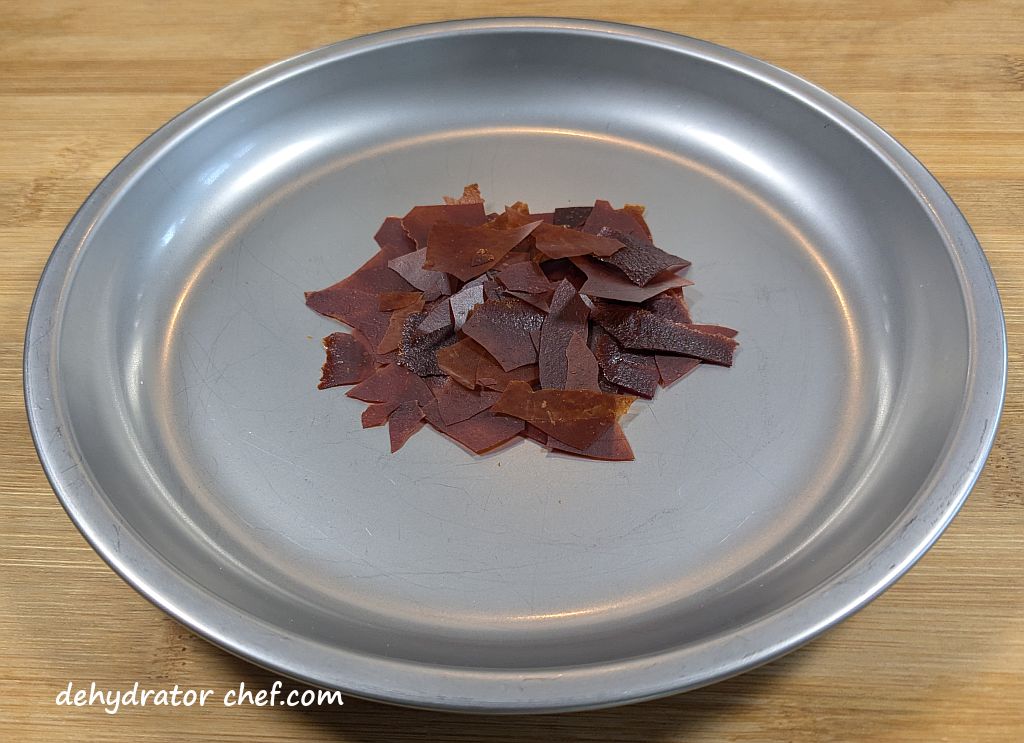
One of dehydrated tomato sauce’s more popular uses is a tomato paste substitute, saving you from opening a whole can only to use a tablespoon or two. To make a paste, combine equal parts tomato powder or chips and warm water.
Tomatoes are a fruit, and tomato sauce is a good source of vitamins A, C, and K, as well as potassium and fiber. A 1/2 cup serving of plain tomato sauce typically contains around 35-40 calories, 8 grams of carbohydrates, and 2-3 grams of fiber. However, some commercial brands of tomato sauce may contain added sugars, sodium, or other crap, so it’s essential to read the label and choose a brand that is low in these additives.
So, let’s get started dehydrating some tomato sauce.
Table of Contents
- How to Dehydrate Tomato Sauce
- Supplies Needed for Dehydrating Tomato Sauce
- Step 1. Process the Tomato Sauce for Dehydrating
- Step 2. Preparing the Dehydrator for Dehydrating Tomato Sauce
- Step 3. Dehydrating Tomato Sauce
- Step 4. When is the Dehydrated Tomato Sauce Done
- Step 5. Equalizing and Conditioning of the Dehydrated Tomato Sauce
- Step 6. Storing Dehydrated Tomato Sauce
- Hydration
- Weights, Measures, and Serving Sizes
- Dehydrated Tomato Sauce Nutrition Information
- Insider Tips
How to Dehydrate Tomato Sauce
Choose a good quality brand-name tomato sauce if you are using something other than homemade. We’ll stock up when there is a sale and rotate out the older inventory for cooking and dehydrating.
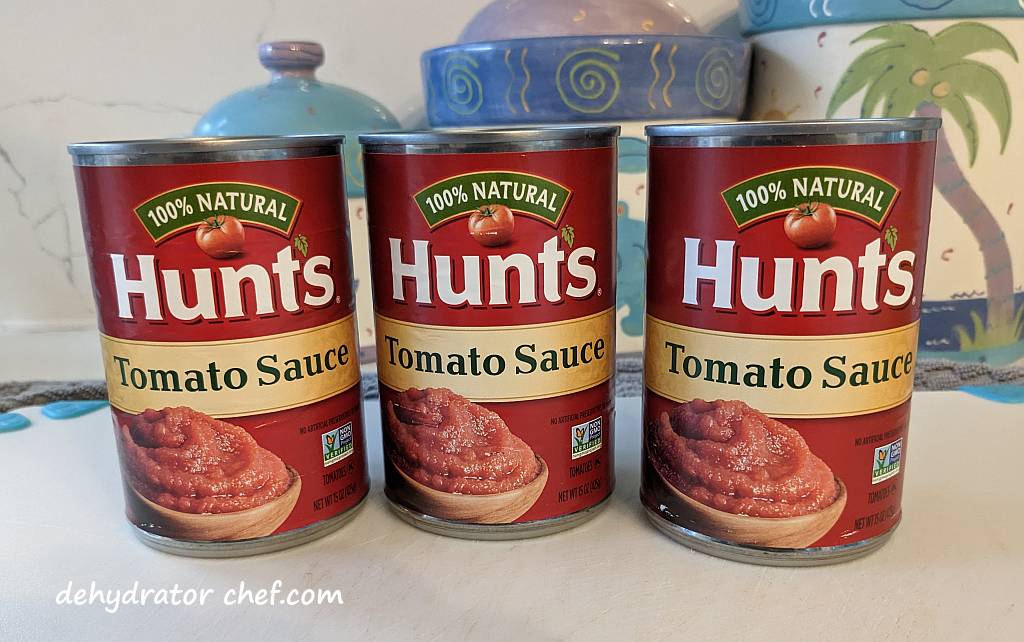
One 15-ounce can of tomato sauce will easily fill one of my Nesco 13.5-inch round dehydrator trays with a fruit roll sheet for planning purposes.
Optionally, thin out the tomato sauce by mixing in 1/2 can of water. With this optional step, you’ll now need two 13.5-inch round dehydrator trays lined with a fruit roll sheet. By thinning out the tomato sauce, you’ll end up with a product that dehydrates more evenly.
The Nesco 13.5-inch round dehydrator tray has close to 119 square inches or .8 square feet of surface area for drying.
All you need to dehydrate tomato sauce is a good quality food dehydrator. We use the Nesco food dehydrators. You can check out our food dehydrator guide to learn why we think Nesco offers the best bang for the buck. We believe this is the best food dehydrator for our long-term food storage needs.
Today, we are using quality name-brand store-bought products without a bunch of added crap ingredients. So, there isn’t much preparation work involved here other than prepping our kitchen gear. So it’s mise en place, a French term for having all your gear and ingredients measured, cut, peeled, sliced, grated, easily available, and within reach.
Supplies Needed for Dehydrating Tomato Sauce
- Food dehydrator
- Removable fruit roll sheet inserts for the dehydrator trays
- Common kitchen tools, including cutting boards, can opener, etc.
- Wide-mouth canning jar funnel
- Canning jars with tight-fitting lids
- Desiccant packets for moisture control (optional)
Step 1. Process the Tomato Sauce for Dehydrating
We plan out our dehydrator project and try to fill up as many trays as practical with similar foods and drying times. Today, we are drying 3 15-ounce cans of a quality name-brand tomato sauce and several cans of diced RoTel diced tomatoes with green chilies.
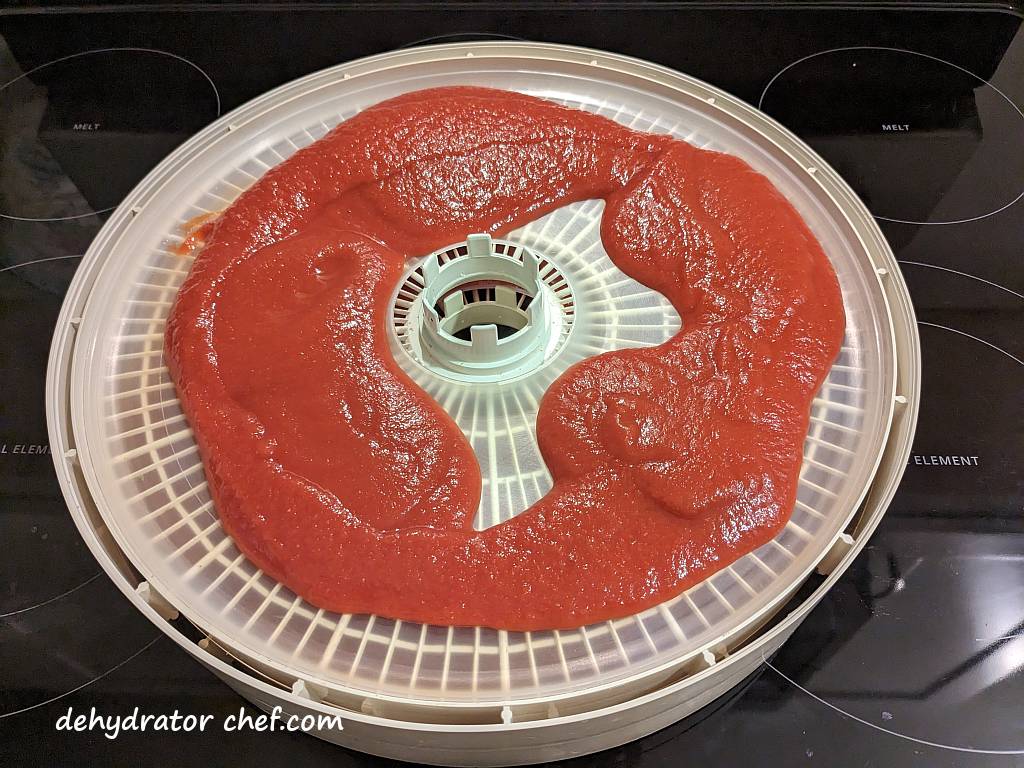
Other than opening the cans, there isn’t much to processing tomato sauce for dehydration. However, if you want to add additional herbs or spices, this is the time to do it.

Step 2. Preparing the Dehydrator for Dehydrating Tomato Sauce
We know from experience that a 15-ounce can of tomato sauce is the right amount to fill one of our Nesco 13.5-inch round dehydrator trays with a removable fruit roll sheet insert.
Just empty the contents of the 15-ounce can onto the fruit roll sheet. Use a spatula to scoop and scrape out every bit of contents from the can, then smooth it all out for even drying.
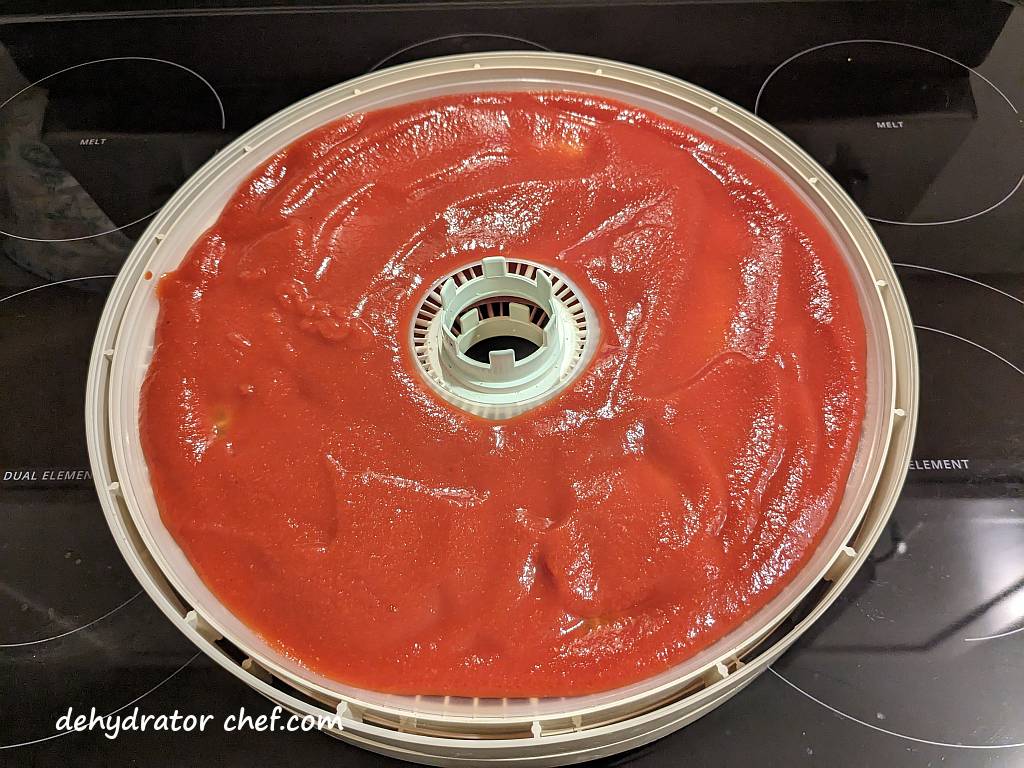
The tomato sauce layer will end up somewhere between 1/8 to 3/16 of an inch thick. The 15-ounce can is just enough to fill the fruit roll sheet insert without overflowing.
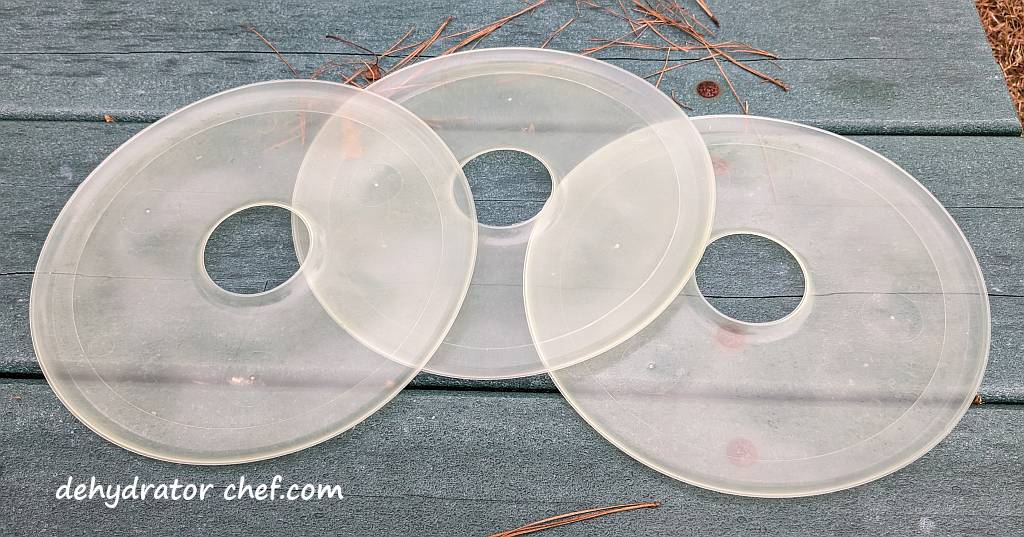
We will use these removable Nesco fruit roll sheet inserts on our food dehydrator for today’s project. They have over 3000 customer reviews with an average rating of 4.5 stars out of 5, which is evidence of a great product. Check out other Nesco food dehydrator products here.
Step 3. Dehydrating Tomato Sauce
Tomato sauce has quite a bit of moisture to evaporate before it’s dry enough. So start dehydrating the tomato sauce at a drying temperature of 160 °F (71 °C). Plan on 12 to 24 hours of drying time. Of course, it’s all dependent on the ambient temperature and humidity and your dehydrator capacity. Remember to use drying times as a guide.
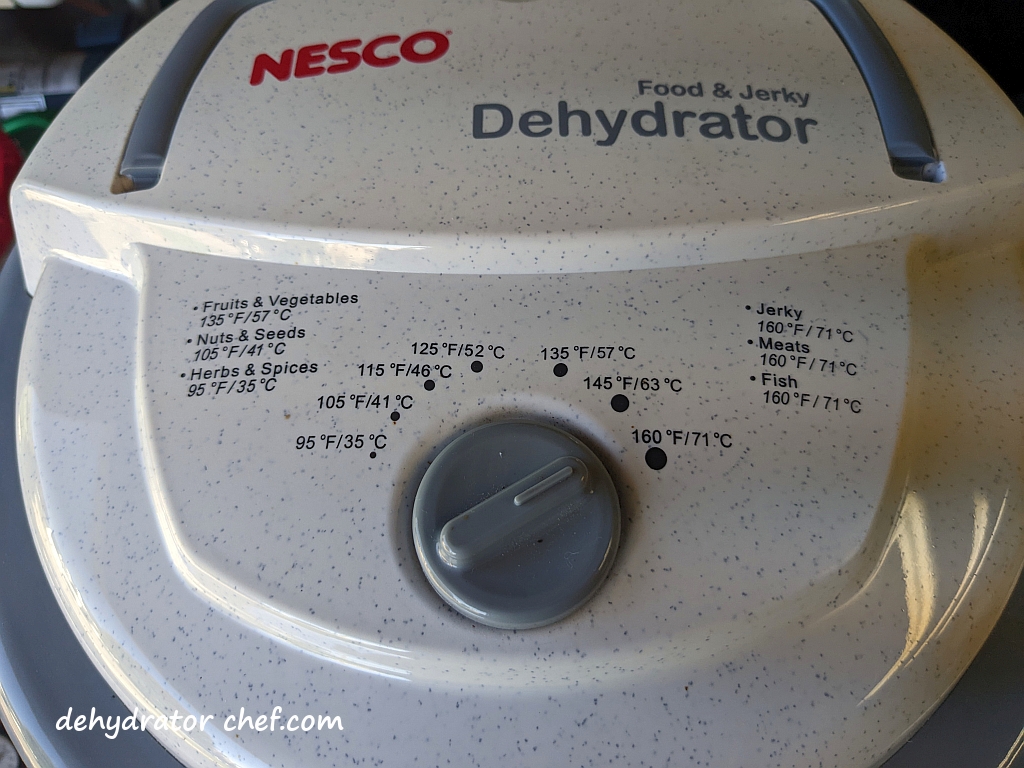
With some dehydrators, rotating the trays helps to speed up the overall drying time. For example, move the top trays to the bottom, and the bottom trays to the top.
After 10 or 12 hours, consider pulling the tomato sauce “leather” from the fruit roll sheet and turn it over to promote even drying.
Step 4. When is the Dehydrated Tomato Sauce Done
After 20 to 24 hours, the tomato sauce should be fully dehydrated. If not, let it go another couple of hours and check it again.
Drying times will vary depending on your dehydrator. Refer to your dehydrator owner’s manual for recommended temperatures and times for dehydrating specific foods. Remember to use drying times as a guide.
Warm tomato sauce “fruit leather” still in the food dehydrator will feel somewhat pliable, and you may believe they need more drying time. Just unplug the dehydrator and let everything cool down.
Wait 15 to 30 minutes, and then check again to be sure. As the tomato sauce cools, it will stiffen considerably. The dehydrated tomato sauce should easily crack into pieces if you try bending it. It should be brittle when done.
Once finished, break the dehydrated tomato sauce into smaller dime or nickel-sized pieces for ease of storage.
Step 5. Equalizing and Conditioning of the Dehydrated Tomato Sauce
We always recommend letting food items cool completely after they have finished dehydrating and before packing them into an airtight storage container for equalizing and conditioning. Warm food may cause sweating, which could provide enough moisture for mold to grow.
It does not take long for dehydrated food items to start hydrating from ambient household humidity. Do not leave dehydrated food items exposed to the elements any longer than necessary because of the increased risk of mold growth.
After a short cooling period, loosely pack the dehydrated tomato sauce pieces into a clean, dry, insect-proof, and air-tight storage container. We use pint- or quart-size canning jars for conditioning. Since the canning jars are clear, it’s easy to see what’s inside.
A wide-mouth canning jar funnel is handy for the task of getting dehydrated food from the trays into the canning jars with minimal spillage. It’s not a necessity, but having one does make the job easier and faster. If you need one, check them out on Amazon.
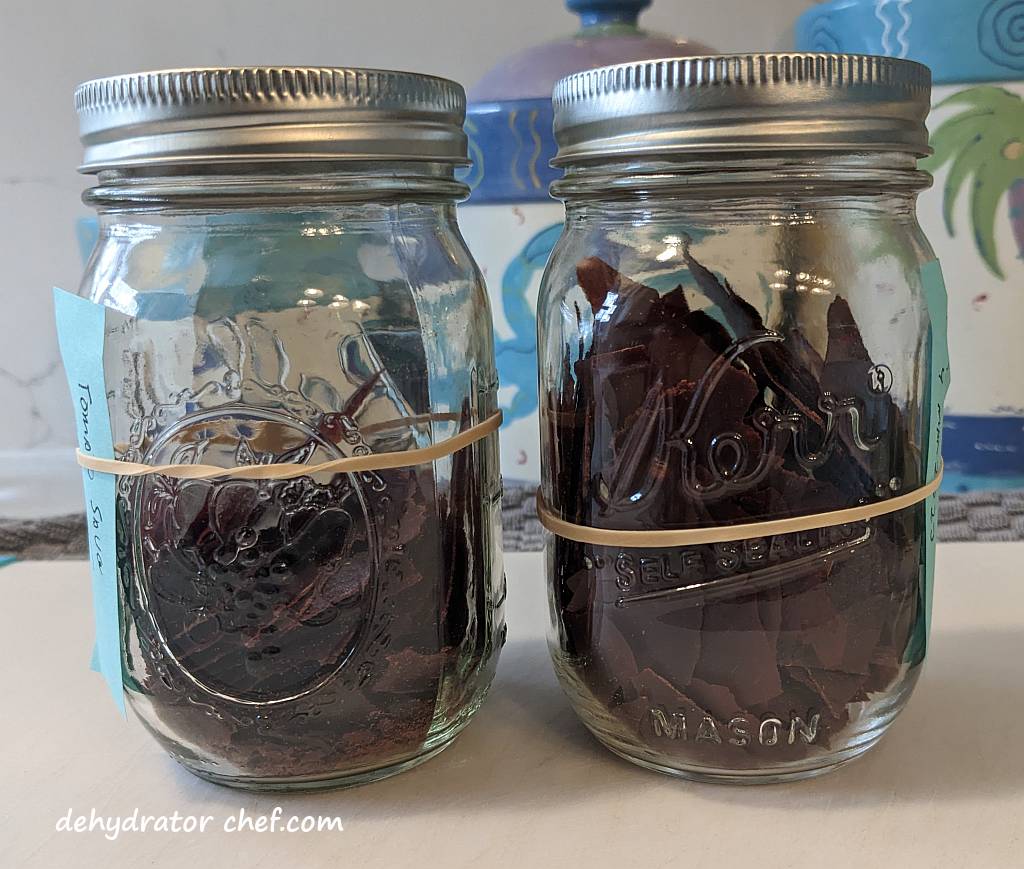
For this project, we had 2 pint-size canning jars that were just cleaned and dried. Leave room in your jars so you can shake and roll the contents around.
When the dehydrated tomato sauce is removed from the dehydrator and broken into smaller pieces, the remaining moisture may not be distributed equally. Equalizing and conditioning is a process for freshly dehydrated foods that ensures any residual moisture remaining in any piece is spread or equalized among all the other pieces in the batch. Let the dried tomato sauce pieces equalize and condition in the storage container for 7 to 10 days.
For this project, we had 2 pint-size canning jars that were just cleaned and dried. Leave room in your jars; don’t overfill them.
Every day, check the jar for moisture. Roll the jar contents around and note any clumping or sticking. If seen, put the contents back on the dehydrator for several more hours. Since canning jars are clear, it’s easy to see what’s inside.
If you notice any mold at all, even the smallest bit, throw it all out. What you see are the mold spores finally blooming enough to make them visible. But there are more, even tinier mold spores in the rest of your jar that make your dehydrated food inedible. Toss it out and start another batch.
Step 6. Storing Dehydrated Tomato Sauce
Use an appropriately sized canning jar for storage. The dehydrated tomato sauce might keep up to 12 months. Exactly how long depends on how well you dehydrate the product and your pantry storage conditions.
We’ll use a food-safe desiccant packet for moisture control because we live in a fairly humid area. For our pint-size or quart-size mason jars, we’ll use a single food-safe 5-gram desiccant packet.
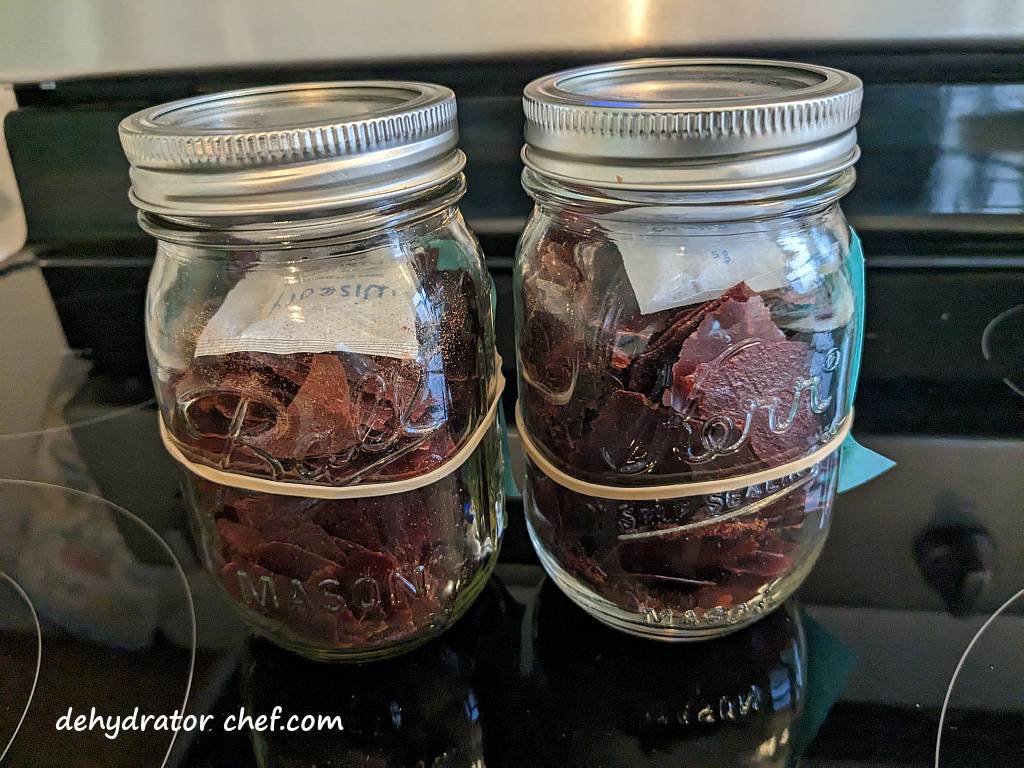
We use these inexpensive food-safe desiccant packets, which are available from Amazon. These 5-gram packets have over 5000 of mostly 4- and 5-star customer reviews, with an average of 4.7 stars out of 5. Our bag of 60 desiccant packets will last quite a while because they can be recharged and reused multiple times. Other food-safe sizes are available.
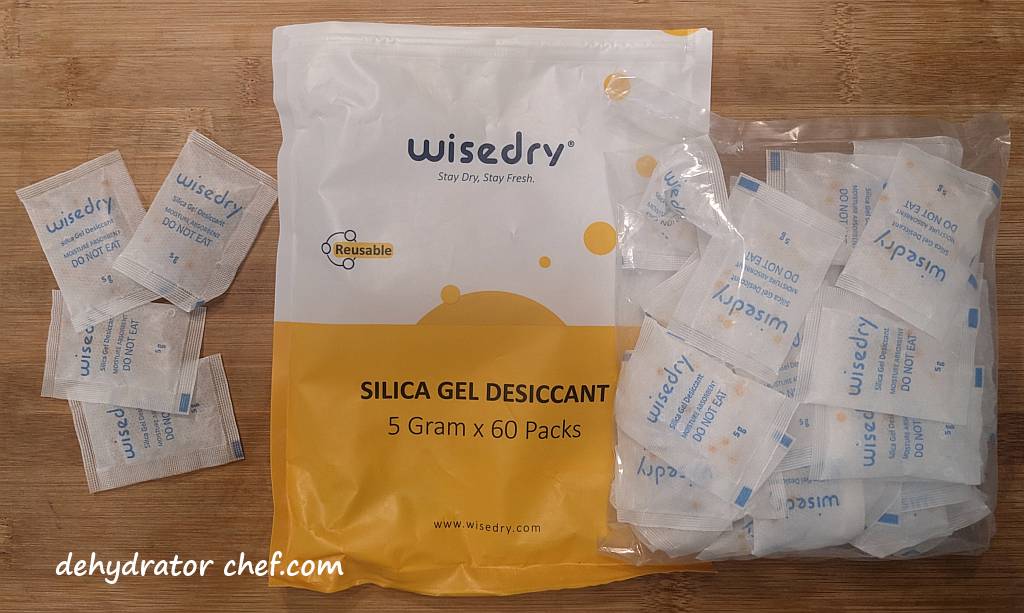
Lastly, I’ll attach or include a short note describing the jar contents and the date the product was dehydrated. The note also lets me know where to go in my dehydrator logbook if I want to make another note or two.
Hydration
Hydrate the dried tomato sauce chips using a 1-to-1 ratio of dehydrated product to boiled water. As a single ingredient, dehydrated tomato sauce doesn’t take long to rehydrate.
If you’re supplementing store-bought freeze-dried meals as we do, just add a tad bit more boiling water to the food pouch. Use the same 1-to-1 ratio of dehydrated tomato sauce chips to water and account for the extra time.
Weights, Measures, and Serving Sizes
Summarizing notes from our dehydrator logbook, a 15-ounce can of tomato sauce, about seven servings of 1/4 cup each, will dehydrate to approximately 46 grams, which is about 6.6 grams per serving.
Dehydrated Tomato Sauce Nutrition Information
Serving Size: 7 grams | Calories: 25 kcal | Total Fat: 0 g | Saturated Fat: 0 g | Cholesterol: 0 mg | Sodium: 15 mg | Carbohydrate: 5 g | Dietary Fiber: 0 g | Sugar: 2 g| Protein: 1 g
 | The Dehydrator Chef Book Available only on Amazon.com You’ll find step-by-step instructions for 26 homemade dehydrated camping meals. Many recipes are only available in this book. Grab yourself a copy today. |
Insider Tips
Consider using a spice grinder to make a tomato powder. This is the spice grinder we use, it’s available at Amazon.com. It has close to 4,000 customer reviews, with an average of 4.4 stars out of 5. It comes with 2 grinding bowls, a 2-blade grinder, and a 4-blade chopper. It’s also easy to clean out the spice residue when you’re finished.
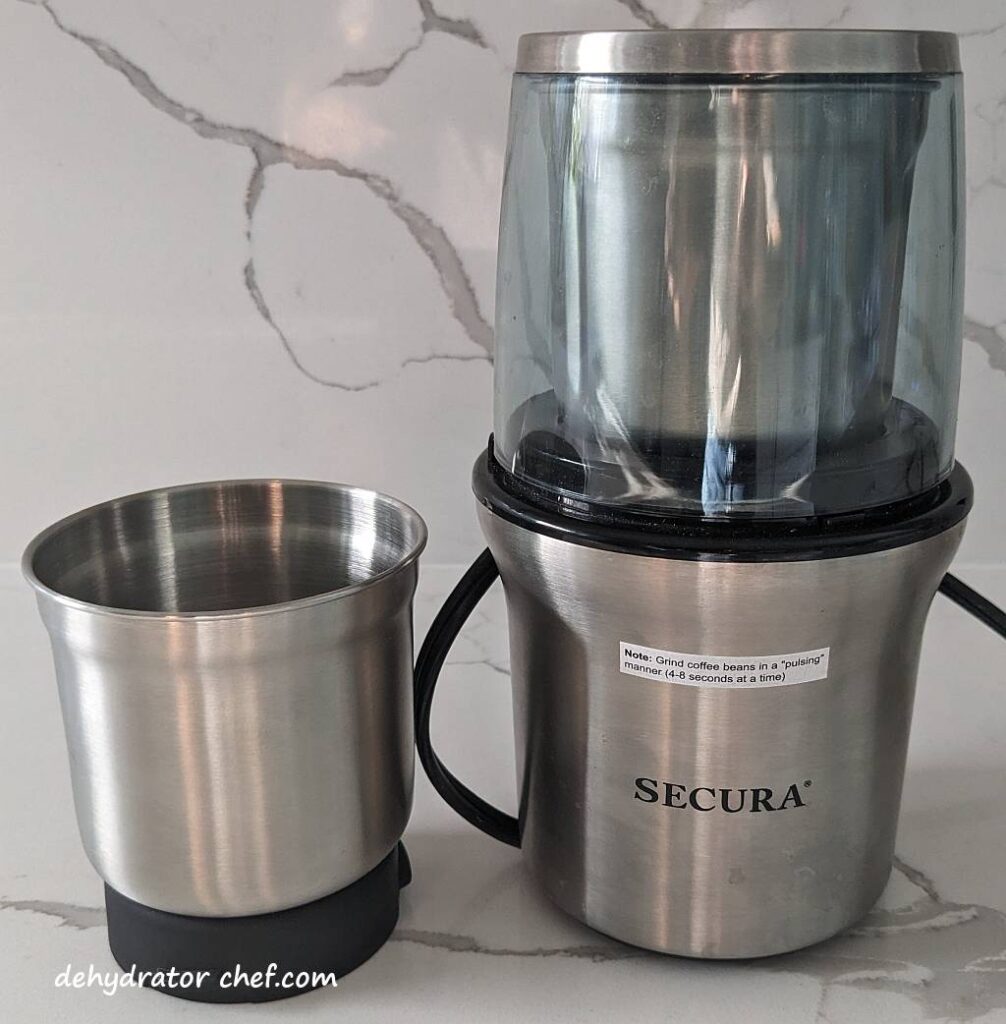
Practice at home making dehydrated camping meals using the very same gear used in the field. We practice reinforcing the skills we have learned. Practice makes perfect.
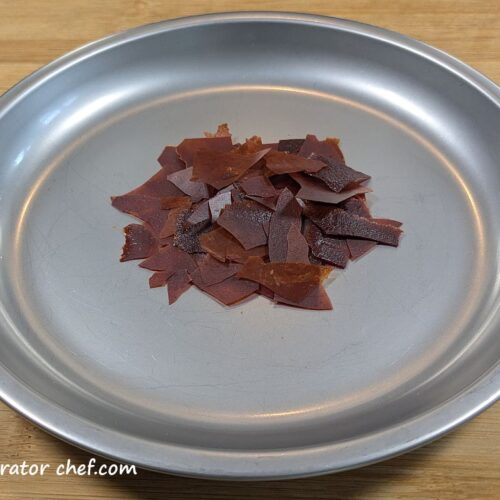
How to Dehydrate Tomato Sauce
Equipment
- Removable fruit roll sheet insert (one for each dehydrator tray)
- Common kitchen tools (including cutting boards, chef's knife, mixing bowls, etc.)
- Canning jars with tight-fitting lids
- Desiccant packets for moisture control (optional)
Ingredients
- several cans Tomato sauce (low-sodium is preferred)
Instructions
Process the Tomato Sauce
- Empty the can of tomato sauce into a mixing bowl, followed by 1/2 can of water. Mix well.several cans Tomato sauce
Prepare the Dehydrator
- Ladel the thinned tomato sauce onto the fruit roll sheet; one 15-ounce can will fill two 13.5-inch round dehydrator trays.
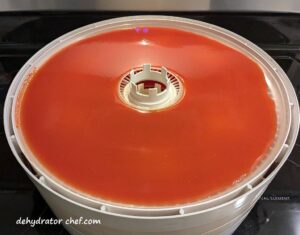
Dehydrate the Tomato Sauce
- Set the dehydrator thermostat temperature to 160 °F (71 °C). Dry for 20 to 24 hours until done.
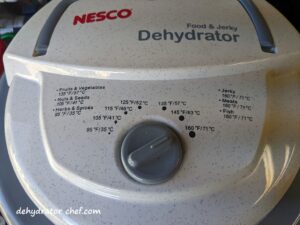
When is the Dehydrated Tomato Done
- When done, the dried tomato sauce should easily break into smaller pieces when bent. There should be no wet areas or mushy pieces.
Equalizing and Conditioning Dehydrated Tomato Sauce
- After a short cooling period, loosely pack the dehydrated tomato pieces into a clean, dry canning jar with a tight-fitting lid, leaving some headspace.
- Every day, for 7 to 10 days, check the jar for moisture. Roll the jar contents around and note any clumping or sticking. If seen, put it all back on the dehydrator for several more hours.
- If you notice any mold at all, even the slightest bit, throw it all out.
Storing the Dehydrated Tomato Sauce
- Use appropriate-sized canning jars for storage. Depending on how well you dehydrate them and your pantry storage conditions, the dehydrated tomato sauce pieces should keep for at least 12 months.

- An optional food-safe desiccant packet will aid with moisture control.

- Attach or include a label describing the jar contents and the date the product was dehydrated. The label identifies the canning jar contents, and the date helps with the rotation schedule. A first-in, first-out rotation helps us to use items that have been on the shelf the longest, so we're using the oldest food first.
Notes
Nutrition
Nutrition information is only an estimate and may differ depending on the ingredients you use.

One reply on “How to Dehydrate Tomato Sauce – Dehydrating Tomato Sauce, A Step-by-Step Guide”
this is probably the easiest to follow dehydrating tomato sauce recipe i have found